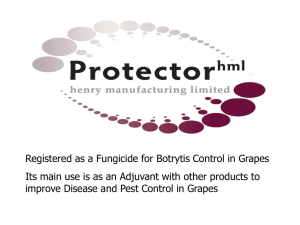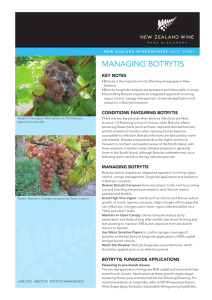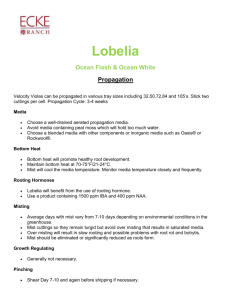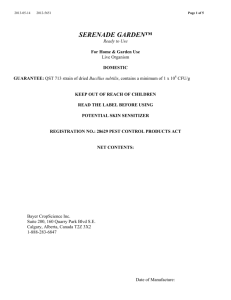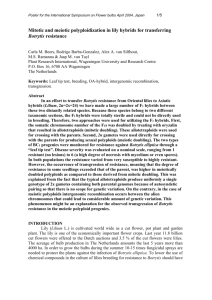Seven Things to Stop Botrytis (Gray Mold)
advertisement
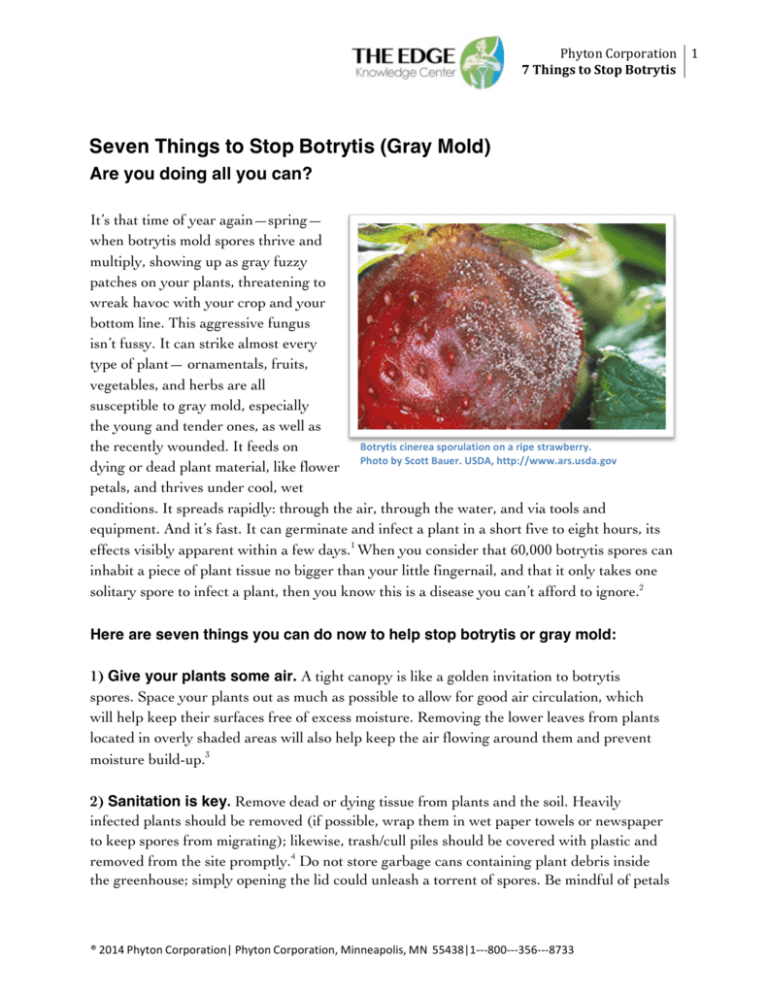
Phyton Corporation 1 7 Things to Stop Botrytis Seven Things to Stop Botrytis (Gray Mold) Are you doing all you can? It’s that time of year again—spring— when botrytis mold spores thrive and multiply, showing up as gray fuzzy patches on your plants, threatening to wreak havoc with your crop and your bottom line. This aggressive fungus isn’t fussy. It can strike almost every type of plant— ornamentals, fruits, vegetables, and herbs are all susceptible to gray mold, especially the young and tender ones, as well as Botrytis cinerea sporulation on a ripe strawberry. the recently wounded. It feeds on dying or dead plant material, like flower Photo by Scott Bauer. USDA, http://www.ars.usda.gov petals, and thrives under cool, wet conditions. It spreads rapidly: through the air, through the water, and via tools and equipment. And it’s fast. It can germinate and infect a plant in a short five to eight hours, its effects visibly apparent within a few days.1 When you consider that 60,000 botrytis spores can inhabit a piece of plant tissue no bigger than your little fingernail, and that it only takes one solitary spore to infect a plant, then you know this is a disease you can’t afford to ignore.2 Here are seven things you can do now to help stop botrytis or gray mold: 1) Give your plants some air. A tight canopy is like a golden invitation to botrytis spores. Space your plants out as much as possible to allow for good air circulation, which will help keep their surfaces free of excess moisture. Removing the lower leaves from plants located in overly shaded areas will also help keep the air flowing around them and prevent moisture build-up.3 2) Sanitation is key. Remove dead or dying tissue from plants and the soil. Heavily infected plants should be removed (if possible, wrap them in wet paper towels or newspaper to keep spores from migrating); likewise, trash/cull piles should be covered with plastic and removed from the site promptly.4 Do not store garbage cans containing plant debris inside the greenhouse; simply opening the lid could unleash a torrent of spores. Be mindful of petals ® 2014 Phyton Corporation| Phyton Corporation, Minneapolis, MN 55438|1-­‐-­‐-­‐800-­‐-­‐-­‐356-­‐-­‐-­‐8733 www.Phytoncorp.com Phyton Corporation 2 7 Things to Stop Botrytis falling from hanging baskets, they attract botrytis spores and should be removed; the same goes for plant debris lying on benches or walkways.5 Use hand sanitizers as much as possible. Treat pruning shears and knives with disinfectant after pruning, and consider using two pruners at a time, alternating pruning with disinfecting the tool as you work.6 (To disinfect cutting tools, you can use X3 at the rate of 0.25 ounces per gallon or 25 ounces per 100 gallons. Soak tools in the solution for at least two minutes.) 3) Be gentle with your plants. Since botrytis seeks out wounded tissue, broken stems, and damaged leaves, it’s important to avoid injuring your plants. Don’t leave large stubs when youtake cuttings or otherwise cause damage.7 Prune in the early afternoon so that leaf-cut wounds will dry quickly.8 Treat infected lesions promptly. 4) Water in the morning. Water-based irrigation or spray operations should be done in the morning so that plant surfaces will dry as the temperature rises during the day. Avoid using overhead irrigation, and do not use spray operations in the late afternoon or on cloudy days. The main idea is to avoid practices that will promote prolonged wetness on plant surfaces. 5) Watch the humidity. Keep the relative humidity (RH) within a preferable range of 80 to 85%. Exchanging the air by turning on the heat and opening up the vents for 5 to 10 minutes can be very effective in lowering RH. Any reduction in RH can significantly help prevent botrytis. Venting heated air carries moisture up and away from your plants and out of your greenhouse. The short period of time it takes to do this does not use a lot of energy, yet it will yield enormous benefit by removing the moisture from the air that would otherwise settle on your plants.9 6) Use fans to reduce moisture. For best results, use fans that produce horizontal air flow, which helps maintain more even temperatures and reduces condensation-producing cold spots.10 7) Use a fungicidal treatment in the spring and fall, when conditions are favorable for gray mold to develop, and/or at the first sign of infection. A favorite among growers for the treatment of botrytis, Phyton 35 (or Phyton 27) can be used to stop botrytis and many other fungal infections throughout your crop rotations. Because it is much easier to prevent a disease than it is to cure it, using a fungicide as a preventative measure is a much more costeffective and efficient method to control this disease. ® 2014 Phyton Corporation| Phyton Corporation, Minneapolis, MN 55438|1-­‐-­‐-­‐800-­‐-­‐-­‐356-­‐-­‐-­‐8733 www.Phytoncorp.com Phyton Corporation 3 7 Things to Stop Botrytis • • To prevent botrytis infestation, use Phyton 35 (or Phyton 27) every 7 to 10 days at the lower (preventative) rate shown on the label. To cure botrytis infestations that have already appeared on your plants, always use Phyton 35 (or Phyton 27) at the highest labeled rates. Do not exceed the labeled rates due to risk of phytotoxicity. Note that while Phyton 27 can be used effectively as a fungicide on your ornamental crops, only Phyton 35 is labeled for use on edible plants. Final points Botrytis, which is most active when the temperature hovers between 55° and 75°F, is most rampant in the spring and fall. During these seasons, it is essential you monitor your crops closely for any sign of this fast-growing disease, which will first appear as a white growth that quickly turns gray, or it may show up on flowers as light or dark brown spots. Gray mold can live year-round in the greenhouse. Spores are often found on the outside of seeds and can remain dormant on plant surfaces for up to three months (or in some cases, the life of the plant).11 By following an integrated plan that includes the above practices, you can significantly reduce your crop exposure to botrytis. 1 Dr. Siva Sabaratnam, “Botrytis Blight & Stem Canker of Greenhouse Tomato, Biology & Disease Cycle of Grey Mould (Botrytis cinerea)," British Columbia Ministry of Agriculture, http://www.agf.gov.bc.ca/cropprot/botrytis.htm (accessed April 13, 2014). 2 Gary W. Moorman, “Botrytis or Gray Mold,” Penn State College of Agricultural Sciences, http://extension.psu.edu/pests/plant-diseases/all-fact-sheets/botrytis-or-gray-mold (accessed April 13, 2014). 3 Sabaratnam, “Botrytis Blight & Stem Canker of Greenhouse Tomato.” 4 Ibid. 5 Josh Gibson, Sarah Williams, and Francesca Peduto Hand, “Botrytis Gray Mold in Greenhouse Floral Crops,” The Ohio State University, College of Food, Agricultural, and Environmental Sciences, http://ohioline.osu.edu/hyg-fact/3000/pdf/Botrytis_Gray_Mold_HYG_3070_2014.pdf (accessed April 13, 2014). 6 Sabaratnam, “Botrytis Blight & Stem Canker of Greenhouse Tomato.” 7 Moorman, “Botrytis or Gray Mold.” 8 Sabaratnam, “Botrytis Blight & Stem Canker of Greenhouse Tomato.” 9 Dr. Robert L. Wick, “Botrytis Blight of Greenhouse Crops,” University of Massachusetts Amherst, The College of Natural Sciences, Agriculture & Landscape Program, Greenhouse Crops and Floriculture Program,https://extension.umass.edu/floriculture/fact-sheets/botrytis-blight-greenhouse-crops(accessed April 13, 2014). 10 Ibid. 11 Moorman, “Botrytis or Gray Mold.” ® 2014 Phyton Corporation| Phyton Corporation, Minneapolis, MN 55438|1-­‐-­‐-­‐800-­‐-­‐-­‐356-­‐-­‐-­‐8733 www.Phytoncorp.com


